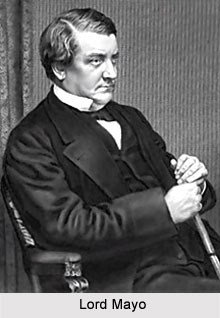 Lord Mayo was an erudite Englishman, who had consolidated the frontiers of India. He also had reorganised the country`s finances, making a sweeping overhaul. Lord Mayo also did much to encourage irrigation, railways, forests and other valuable public works. Mayo College in Ajmer, following the European line of education, was founded by him. The college primarily catered to the education of young Indian native chiefs, with 70,000 pounds being subscribed by the chiefs themselves.
Lord Mayo was an erudite Englishman, who had consolidated the frontiers of India. He also had reorganised the country`s finances, making a sweeping overhaul. Lord Mayo also did much to encourage irrigation, railways, forests and other valuable public works. Mayo College in Ajmer, following the European line of education, was founded by him. The college primarily catered to the education of young Indian native chiefs, with 70,000 pounds being subscribed by the chiefs themselves.
In the period within 1869 to 1870, following his examination of the budget, Lord Mayo responded with a series of measures to balance a projected deficit of 1,650,000 pounds in the Government of India`s budget. He slashed 800,000 pounds from the Public Works Department and 350,000 pounds from other governmental departments. To increase revenue, the income tax was increased and the salt tax in Madras and Bombay was increased. Total new revenues from these measures earned approximately 500,000 pounds. In his longer term, Lord Mayo improved the workings of the Finance Department by making local governments more responsive in budget matters and by making adjustments in expenditure and income more systematic.
Lord Mayo further made additional fiscal reforms and budget savings in the military budget by eliminating eleven European regimental headquarters by transferring troops to other regiments. This consolidation, when also imposed on the artillery, proposed to save approximately 568,762 pounds. Further consolidation within the three Presidency armies projected further savings. The portions of this plan when actually executed yielded an annual savings of 591,440 pounds.
On 14th December, Lord Mayo issued his Charter of the Provincial Governments. This document laid out a programme of Provincial Services, whereby the Government of India allocated a consolidated grant of revenue to each local government to bear the cost of its services, including public works, but excluding military expenses. The grant could be used entirely as determined by the local government.
On 9th May, Lord Mayo took over the supervision of the Public Works Department. As an activist, he held a particular interest in the efficient use of funds, on the effectiveness of administration and for the construction of roads, railways and irrigation works. On 9th June 1871, Lord Mayo established the new Department of Revenue, Agriculture and Commerce. He appointed Allan Octavian Hume as the department`s first Secretary. The department assimilated area like forestry from the Public Works Department, studs and horse breeding from the Military Department, land revenue and settlements from the Foreign Department and agriculture and horticulture from the Home Department.
Lord Mayo`s fiscal reforms were indeed much necessary to the crestfallen Indian revenue system during the ongoing British Raj. His keen observation in every financial matter, deep pondering for the administration`s betterment, gave the rulers a much-needed breath of fresh air.



















